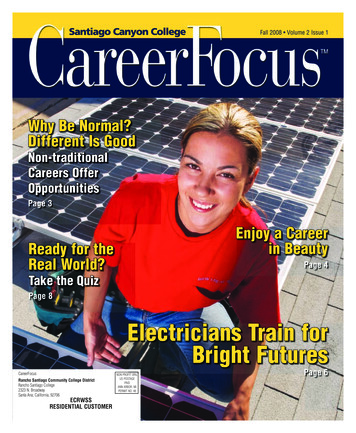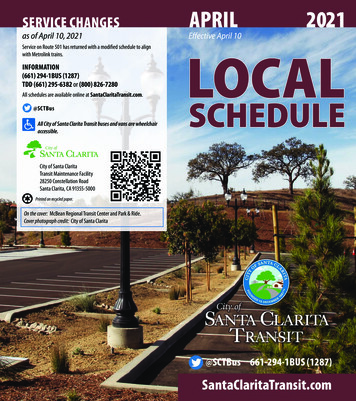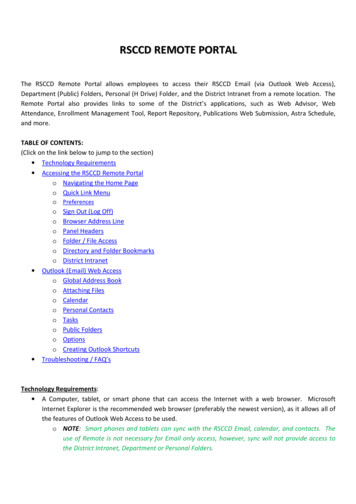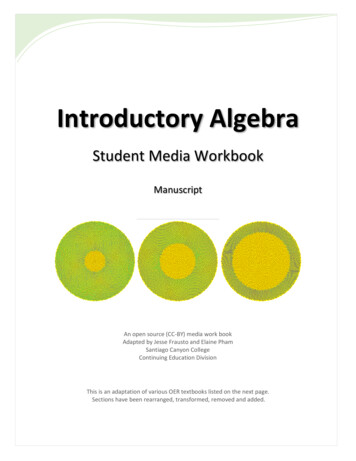
Transcription
Fall 2008 Volume 2 Issue 1Why Be Normal?Different Is GoodNon-traditionalCareers OfferOpportunitiesPage 3Enjoy a Careerin BeautyReady for theReal World?Page 4Take the QuizPage 8Electricians Train forBright FuturesCareerFocusRancho Santiago Community College DistrictRancho santiago College2323 N. Broadwaysanta ana, California, 92706ECRWSSPOSTALPATRONRESIDENTIAL CUSTOMERNON PROFIT ORG.us POsTaGePaIdaNN aRBOR, MIPeRMIT NO. 48Page 6
Top Reasons to ChooseSantiago Canyon CollegeFriendly, knowledgeablefaculty and staffFlexible class schedules—choose from days, evenings,weekends and onlineExcellent student services,including financial aid andscholarships, transfer andcareer assistance, on-site childcare and moreProfessional career trainingby experts working in theirfieldsSuperior value at just 20per unitAward-winning student teamsand activities, including oneof California’s top communitycollege women’s soccer teams8045 E. Chapman Ave.Orange, CA 92869(714) 628-4901sccollege.edu
Editor .Judy IannacconeManaging Editor . AnnMarie LibrescuCover Photography . Davis BarberInside Photography .Davis Barber & Eric HarsenContentsFeatures2Facts and Finds3Why Be Normal? Different Is Good4Enjoy a Career in Beauty6Electricians Train for Bright Futures8Ready for the Real World?9SCC Education Facts13Continuing Education ClassesOffer Free In-Demand TrainingAd Design . Eric HarsenVisit SCC on the Web atwww.sccollege.edu.Rancho Santiago Community College DistrictBoard of TrusteesPhillip E. Yarbrough, PresidentR. David Chapel, Ed.D., Vice PresidentLawrence R. “Larry” Labrado, ClerkAlfredo M. Amezcua, J.D.CareerFocusQuestions about Santiago Canyon College’s programs and servicesdescribed in this publication should be directed to the Office ofAdmissions at (714) 628-4901 or view the college’s Web site atwww.sccollege.edu. Comments or questions about the publicationitself can be directed to the SCC Public Information Office at (714)628-4745.Brian E. Conley, M.A.Non-traditional careers offer opportunitiesCosmetology is always in styleNeed for skilled workers growsTake the quizJohn R. HannaLisa Woolery, APR, M.A.Paul Z. Garcia, Student TrusteeSCC Programs from A to ZChancellorEdward Hernandez, Jr., Ed.D.President, Santiago Canyon CollegeJuan VázquezCareer Focus is published by Rancho Santiago Community CollegeDistrict, 2323 N. Broadway, Santa Ana, California, 92706-1640, inpartnership with Washtenaw Community College, Ann Arbor,MI 48106.All rights reserved. No part of this material may be reproduced orused in any form or by means, electronic or mechanical, includingphotocopying, recording, or by any information storage retrievalsystem without the permission of the publisher.NONDISCRIMINATION POLICYThe Rancho Santiago Community College District complies with allfederal and state rules and regulations and does not discriminateon the basis of race, color, national origin, gender or disability.This holds true for all students who are interested in participatingin educational programs and/or extracurricular school activities.Harassment of any employee/student with regard to race, color,national origin, gender or disability is strictly prohibited. Inquiriesregarding compliance and/or grievance procedures may be directedto the District’s Title IX Officer and/or Section 504/ADA Coordinator.Profiles5577Dane O’BarrBarbering StudentAnn EverettCosmetology InstructorChristina McDonaldElectrician ApprenticeSteve VasquezElectrician ApprenticeshipProgram InstructorRSCCD Title IX Officer and Section 504/ADA Coordinator:John Didion2323 N. BroadwaySanta Ana, CA 92706(714) 480-7489 2008 Rancho Santiago Community College DistrictOn the cover:Christina McDonald studies in the SCCElectrician Apprenticeship Program.I714-628-4901 Santiago Canyon College I www.sccollege.eduCareerFocus I Fall 2008I1
CareerFocusFacts and FindsANMoreChooseCommunityCollegeAs a collegeeducationbecomes moreimportant fora good job,enrollment incommunitycolleges and universities is on therise. And while the high tuition ofprivate colleges and universitiesgets a lot of press, the reality isthat most students choose publicuniversities and community collegeswhere tuition rates are much lower.DMoreWorkersPutFamilyFirstHow importantis your work?How about yourfamily; howimportant arethey? Gen-Xand Gen-Yare answeringthose questions differentlythan the Baby Boomers in theworkplace before them.Younger workers are more likelythan older workers to describethemselves as “family-centric”rather than “work-centric.”ExerciseWhileYou WorkHere’s a look at the reality ofcollege attendance: Fifty-six percent of all studentsare enrolled in communitycolleges – a 20 percentincrease over the past decade. From 1995 to 2007 overallenrollment in college increased22 percent, meaning about 2.2million more students are incollege today than in 1995. Nearly half of all collegestudents attend schools wherethe average in-statetuition and fees areless than 2,550. Four out of five students areenrolled in public colleges oruniversities.Source: UnitedStates GovernmentAccountability Office reportNovember 2007A report from the Families andWork Institute indicates thatyounger workers are more likelythan older workers to describethemselves as “family-centric”rather than “work-centric.”Twenty-two percent of BabyBoomers say they prioritize workover family but only 12 and 13percent of Gen-X and Gen-Y saythe same thing. In contrast, just41 percent of Boomers describethemselves as “family-centric”with 50 percent of Gen-Xers and52 percent of Gen-Yers sayingthe same.A nearly even percentageof workers of all ages calledthemselves “dual-centric”putting equal weight on workand home life. For Boomers itwas 37 percent, Gen-Xers 35percent and Gen-Yers37 percent.IntrovertsWantedIf you findit easier tobe part ofthe human racewithout always being part of thesocial hubbub, you might want totake a look at the new book 200Best Jobs for Introverts. Introvertsthrive on working independentlyand with relatively low contactwith others. They don’t gainenergy from social interactionsthe way extroverts do, but thatdoesn’t exclude them from makingsignificant contributions thoughtheir work.ISimply put, peoplewho move more,tend toweigh less,so why not add activitywhile doing otherwisesedentary tasks such asworking at a desk orcomputer? The “officeof the future” developedby Levine combinesa treadmill with acomputer workstationso workers can walkslowly while working.A one-mile-an-hour walkwhile working burns about100 calories an hour or 800calories for a full day. With nochange in food intake, walkingworkerscould looseas much as50 pounds ayear.those on the quietCareerAnnual earningsLawyerComputer software engineerFinancial analystFashion designerMicrobiologistTechnical writerCost Estimator 98,930 82,120 63,860 60,860 56,870 55,160 52,020Two YearsAre Betterthan Four2 Fall 2008 I CareerFocusout while you’reworking at yourcomputer. DrJames Levine ofthe Mayo Clinicdeveloped a plan forintegrating exerciseand office workbased on somethinghe calls NEAT (NonExercise ActivityThermogenesis).Some of the highest paying jobsside are:Even more important thoughwas this finding: “Employeeswho are dual-centricor family centricIn July 2007, Theexhibit significantlyNew York Timesbetter mental health,invited collegea greater satisfactionstudents to submitwith their lives, andessays in responsehigher levels of jobto an article by Rick Perlstein titledsatisfaction than“What’s the Matter with College?”employees who areSix hundred students responded.work-centric.”Runner-up Liz Addison of SouthernIn other words, thekey to a happy andproductive work life isto know when to just gohome!What a simpleand smart idea!Instead of sittingat a desk all day,why not workMaine Community College inPortland, captured the spirit of thecommunity college in her essay “TwoYears Are Better than Four.”“The philosophy of the communitycollege, and I have been to two ofthem, is one that unconditionallyallows its students to begin. Justbegin. Implicit in this belief is theunderstanding that anything andeverything is possible. Just followany one of the 1,655 road signs, andpop your head inside – yes, they letanyone in – and there you will finddiscoveries of a first independent film,a first independent thought, a firstindependent study.”Read the entire essay at: tter-than-four. CFSantiago Canyon College I www.sccollege.eduI 714-628-4901
CareerFocusFeatureWhy Be Normal? Different Is GoodNon-traditional careers offer opportunitiesBy Michelle Marczak, Ken Reed, and Laura LyjakEvery year about six millionadults head back to college.They range in age from25 to 65 and sometimesbeyond. Students oncereferred to as “nontraditional” arebecoming moreand more commonon campuses. Infact, the over-40college student isthe fastest growingsegment in highereducation.Entering a field whereyour gender is not usuallyrepresented can be a challenge.But we’re guessing that issomething you have alreadyconsidered. Check out these benefitsand then ask yourself if being “nontraditional” is a bad thing: Non-traditional careers oftenoffer better pay for women andmore job opportunities for bothgenders. Non-traditional careersusually have established stepsfor advancement – in theconstruction trades, workersmove from apprentice to journeyperson to superintendent. Most non-traditional jobsrequire specialized skills,which are usually compensatedaccording to the amount oftraining or education. WOMENConstructionDentistsElectriciansEngineersFire Science OccupationsGroundskeepersLaw Enforcement OccupationsMachinistsTruck DriversWeldersIMENAccounting ClerksChild Care WorkersClerical and AdministrativeSupportDental AssistantsLibrariansLicensed Practical NursesMedical Lab TechniciansThe reasons can rangefrom a layoff to a promotionRegistered Nursesto a long-deferred dream.There is no doubt thatSecretariesgetting a college degreeTeacher’s Aidesis a bit more complicatedwith kids, mortgages andday jobs, but most adultThere is nothing “non-traditional”students discover it’s well worth it.about entering into a career thatfeels natural to you, no matter yourYour decision to return to schoolgender or age. CFprobably is going to be the result ofMany non-traditional careers inthe skilled trades have potentialovertime pay. Also, these jobsNon-traditionalchoices forNon-traditionalchoices forjob candidate to someemployers.here is no such thing as“women-only jobs,” “men-onlyjobs,” or “jobs for the young.”There are only jobs. Period. A“non-traditional career” is onein which 25 percent or less of acertain gender is represented.provide a greater variety ofschedules or shifts. The greater the range ofexperience a job offers and themore options it makes available,the greater the chance for selfsatisfaction.The term “non-traditional” ineducation may also refer to aperson’s age, meaning you aren’t astudent right out of high school. Butit’s not a disadvantage. Oftentimesyour previous experiences andmaturity may make you a bettersome soul-searching. The first stepis to explore – yourself, your values,skills and interests, your hopesand dreams. Then explore thejob options that fit your goals.And if the result is a career thatrequires more education, startplanning how you can make thathappen.now?KuoYdiDpresent4 reges 16 to 3 bile Women atot o f au moone percenmechanics.rcent ofsent 7.2 pe Men repre urses.There are some advantages toregistered nbeing older and having a job.leOften you can test out of classes if2010, peop oolBy the yearch shighyou have extensive work experiencean awith less th be able to fill onlyillin the field – saving you both timeeducation w f all jobs.otand money. If you’re working whilenercepnineyou go to school, many businessespriseen will com emow0102will fund all or part of your tuition Byof th52 percentif your classes relate to your currentmore than.profession.labor forceHelpful Web Sites for Adult StudentsAdult Student Center – Specifically for adult students returning to college: www.adultstudentcenter.comChanging Course – Discover the right career for you: www.changingcourse.comFree Application for Federal Student Aid – All you need to apply for federal grants and loans: www.fafsa.ed.govSuper College – Find out about scholarships and plan your return to college: www.supercollege.comAmerica’s Career Info Net – Tons and tons of great information on careers and college: www.acinet.org714-628-4901 Santiago Canyon College I www.sccollege.eduCareerFocus I Fall 2008I3
CareerFocusFeatureEnjoy a Career inBeautyBy AnnMarie Librescu and Catherine CateCosmetology is always in styleIt is hard to think of aproduct or service thateveryone uses—onethat always is neededby both men and womenthroughout their lives.Master one or morecosmetology skills (suchas hair, skin or nail care)in the program SantiagoCanyon College offersthrough a contract withthe fully accredited Hair CaliforniaBeauty Academy in the city ofOrange, and you will always be ableto create beauty while you earnmoney working full or part time, andoften on your own terms!What does acosmetologist do?Whether you want to cut hair, givemanicures, pedicures, performskin care and makeup applicationor provide other personal servicesfor profit, you must be licensedby the California State Board ofBarbering and Cosmetology as aprofessional in one or more of thesefive areas: cosmetologist, esthetician,manicurist, barber or electrologist.While there are some overlappingareas of skills and training,specialized knowledge isrequired. For example, a licensedcosmetologist may cut and stylehair, perform phases of manicuring,apply makeup and provide skincare (within the scope of thelicense) for profit. And although abarber receives training in all theskills related to cosmetology, thebarber’s licensing exam does notinclude manicures, pedicures or theapplication of makeup or artificialnails, explained Thui Minetti, ownerof Hair California Beauty Academy.“Barbers may do a form of facialdesigned especially for male clients,but they do not perform manicuresor pedicures for men.”An esthetician has more extensivetraining and expertise in facial skincare and makeup application and,after passing the licensing exam,may provide skin care and makeupservices and work in cosmetic salesin any licensed facility such as asalon, spa, resort, dermatologist orplastic surgeon’s office.Santiago Canyon College offerscertificate programs in cosmetology,cosmetician (esthetician) andmanicuring through Hair CaliforniaBeauty Academy, which alsoprepares students in all five areasI4 Fall 2008 I CareerFocuscovered by the California licensingexam.Can I earn college credit?Yes! The associate degree andcertificate in cosmetology aredesigned to exceed minimumCalifornia State Board ofCosmetology standards.To receive the associate of sciencedegree in cosmetology, you mustcomplete a minimum of 60 units thatinclude the certificate program andgeneral education requirements withan overall grade point average of2.0. You must complete a minimumof 12 units at Santiago CanyonCollege and at least six of thoseunits must be in courses requiredfor your major. You can earn yourassociate degree, and even transferto a four-year school, earning aliving while you continue learning ina classroom.growing. According to data providedby the Bureau of Labor Statistics,in 2006, there were 677,000 barbersand cosmetologists. By the year2016, that number is expected togrow by 11 percent. Your incomeincreases as you gain experienceand build a steady clientele, possiblyreaching more than 50,000annually, depending on where youwork and the services you provide.With new classes starting almostevery month, many offered duringthe day and evening hours, it’salways the right time to check outthe cosmetology program offeredthrough Santiago Canyon College.For more information, visit the Website at www.sccollege.edu/careereducation or call (714) 628-4883. CFCan I get a job aftergraduation?Cosmetology career options arealmost unlimited and the demand isSantiago Canyon College I www.sccollege.eduI 714-628-4901
Being a Barber IsLiving History with a FutureStudent is a man with a plan anda backup plan!By AnnMarie Librescu andCatherine CateDbarber.ane O’Barr plans to geta college degree that willenable him to teach highschool history. His backupplan is to be employed as aHow did O’Barr, 22, decide on thisunusual combination of careers? Hewas influenced by his love of history.“I got my hair cut in a vintage barbershop and loved the atmosphere:the humming clippers, the smell ofaftershave. It’s eternal and classic—and traditional barber shops arecoming back!” O’Barr explained.But he also was influenced byother factors, both pragmatic andentrepreneurial. “I want a collegedegree, and a skill that will give mea solid fallback position. I can earngood money as a barber and alsohave a flexible schedule while I go toschool or teach,” he explained. O’Barralready is looking forward to openinghis own barber shop.At just 20 per unit of college credit,his path to becoming a barber isaffordable. He attends class orpractices his skills at Hair CaliforniaBeauty Academy in Orange eighthours a day, five days a week.It takes about 10 months to completethe 38 units of study and acquire the1,500 hours of experience needed totake the California barber licensingexam.Of course, his skills already are indemand among family and friends,and “I try to get everyone to come tothe academy, because we get pointsevery time we perform servicesthere,” he explained.After completing his studies at theacademy, O’Barr plans to attendCalifornia State University, LongBeach, to complete his bachelor ofarts degree and obtain his certificateto teach history.If all goes according to plan–O’Barr’splan–he will be teaching in theclassroom and cutting hair in atraditional barber shop in less thanthree years. CFCosmetology Instructor Promotes ProfessionalismBeauty academy provides real-world experienceBy AnnMarie Librescu andCatherine Cateteaching classes for her church. Before trainingas a cosmetologist, she was employed as acorporate project manager.nn Everett has always had a passionfor teaching so she was a natural tobecome an instructor after completingher own training as a cosmetologistat Hair California Beauty Academy inthe city of Orange. Hair California is SantiagoCanyon College’s contract cosmetology provider.It is this unique combination of experience thatmakes her aware of the qualities students needto be successful in the fields of cosmetology andbarbering.A“It is very rewarding to help people improvetheir appearance and feel better aboutthemselves,” said Everett, a licensedcosmetologist who teaches skin care. “I wouldencourage anyone who enjoys working withpeople to look at careers in the beauty industryoffered through Santiago Canyon College.”She added, “The academy provides study inboth theory (book instruction) and practical(hands-on) learning. Students work withthe public after 400 hours of study, and aresupervised by instructors. As a former studentand an instructor, I know that the academymaintains a professional environment thatprepares students with real-world experience.”“You must be able to work with others, lookand act professionally, and have a passion forthe industry, which is always growing andchanging,” she added.Continuing education is critical for careergrowth, Everett said. “Cosmetology is a fieldin which new styles, products, and techniquesare always being developed. Hair Californiaprovides initial training for licensure, as wellas weekend continuing education classes in ‘hottopics’ such as hair extensions. I urge studentsto take advantage of everything we offer toprepare them for great careers in the beautyindustry.” CFGiving students the skills they need toaccomplish their goals reinforces Everett’slife-long love of teaching, which has includedbeing a swim coach and instructor, as well asI714-628-4901 Santiago Canyon College I www.sccollege.eduCareerFocus I Fall 2008I5
CareerFocusFeatureElectricians Trainfor Bright FuturesBy AnnMarie Librescu and Catherine CateNeed for skilled workers growsanted: male andfemale applicantsto receive paidtraining to becomeelectricians. Freeinstruction and onthe-job trainingis provided by theSantiago CanyonCollege ElectricianApprenticeshipProgram,offered throughthe Orange County ChapterInternational Brotherhood ofElectrical Workers (IBEW) Local441.Why? Because every time you flipa switch, press a button, turn aknob—or even a faucet—electricityprobably is involved.Turn on a faucet? Yes. Instead ofdrawing hot water from a waterheater, many modern plumbingsystems are hooked into electricheaters that produce hot water onlyon demand. It’s estimated that 12percent of the state’s electricityis used to pump water to usersstatewide.Applicants may choose between twoprograms: the Industrial Option forInside Wireman (high-voltage) orthe Sound and Communication (lowvoltage) Option. This is a five-yearprogram (10 semesters of nighttimeinstruction, one evening a week)that includes 8,000 hours of paid onthe-job training as an apprentice,earning approximately 12-15 perhour.A number of “green” energysaving measures that companiesuse today also require electricity.For example, energy collected bysolar cells (called photovoltaic orPV electrical systems) requires anelectrician’s expertise to install.Other innovations that requirewell-trained electricians includethe energy-efficient intense lightprovided by Light Emitting Diodes(LEDs).College credit is earned for theclassroom and supplementalinstruction, and apprentices pay onlyfor instructional materials, such astextbooks.Those are just a few examples ofinnovations that require electricianswho have the most up-to-datetraining in a field that is expected togrow about seven percent by 2016,Apprentices whosuccessfully completethis program willattain journeymanstatus, and will havesatisfied requirementsfor an associate degreethrough SantiagoCanyon College aswell as a certificate ofcompletion.The median incomefor electricianswho have achievedjourneyman status isapproximately 22 perhour, or about 45,000per year, according tothe May 2007 Bureauof Labor Statistics.IElectricians are neededeverywhere!6 Fall 2008 I CareerFocusaccording to the Bureau of LaborStatistics, which states, “In additionto jobs created by the increaseddemand for electrical work, manyopenings are expected over thenext decade as a large numberof electricians retire. This willcreate very good job opportunities,especially for those with the widestrange of skills, including voice, data,and video wiring.”No wonder Santiago Canyon College(SCC) is recruiting both men andwomen to join more than 400apprenticeship students who alreadyare preparing for a career with areal future.Quality instruction meetscollege standardsWhile instructors are providedby the local union, and eveningclasses are held in a speciallyequipped instructional facility inthe union hall at 717 S. Lyon Streetin Santa Ana, it is Patti Dillon,SCC apprenticeship programdirector, who is responsible foroverseeing apprenticeship academicrequirements.“We make sure students are properlyregistered, track their attendance,and ensure that the instructionis college-level and approved bythe State Chancellor’s office. Wehire the instructors, verify thatthey are journeymen in their areaof expertise, and are qualified toteach at the college level,” Dillonexplained.“This is a wonderful program forpeople who like to earn while theylearn on the job,” Dillon said. “Theinstructors are so dedicated to theirprofession, and teaching their tradeto the highest standards.”To be eligible for SCC’s electricianapprenticeship program, you must be18 years of age when you apply, havea high school diploma or equivalent,have successfully completed oneyear of high school Algebra 1 or theequivalent with a grade of “C” orbetter, and demonstrate that you arefluent in English.Electricians enjoy steadyemployment with great pay andbenefits. To learn more, visit theWeb site at www.sccollege.edu/careereducation or call (714) 628-4883. CFSantiago Canyon College I www.sccollege.eduI 714-628-4901
Apprenticeship SuitsStudent’s Learning StyleShe finds perfect career as an electricianBy AnnMarie Librescu andCatherine CateElectrician’s Union Local 441 in cooperation withSantiago Canyon College.”When she was a child, ChristinaMcDonald followed her father as heworked around the house, which was“in a state of constant remodel,” sheremembered.“I was always around construction. I was the kidwho was ready to help; whatever needed to bedone, I was willing to do it.”McDonald, 24, a single parent of two, wanteda satisfying career with opportunities foradvancement.After taking a number of college classes, includingalgebra, language arts, sociology and psychology,McDonald decided she was more interestedin hands-on learning. “I enjoyed electricalwork, so when I was 20 I entered the threeyear apprenticeship program for sound (lowvoltage) electricians and got my journeyman’scard. Because I wanted greater intellectualchallenges and more variety, I entered the highvoltage (Industrial Option for Inside Wireman)apprenticeship program that’s taught through theApprenticeship programs have proven to be aperfect fit for McDonald, who finds she learns bestby doing. “When I can see it, then do it, I get it!”Although the job can be physically demanding,McDonald is usually up to the challenge. “I don’texpect to be catered to; I carry bundles of pipe justlike everyone else,” she said.As an apprentice, McDonald always works underthe supervision of a foreman or journeyman.She receives regular job reports that includeattendance at work and in class, as well as effortand attitude. “You have to go to class, read thetextbooks and do the lab work. But the payoff isworthwhile. It’s a really good career, with excellentpay and benefits, and raises every six months.”McDonald’s ultimate career goal is to become aunion-licensed contractor. “I’d like to have my ownbusiness,” she said.“I didn’t know this when I started theapprenticeship program, but both my grandfatherand great-grandfather were college-educatedelectrical engineers,” McDonald said. “Apparently,it runs in my family.” CFElectrician Apprenticeship InstructorCombines Theory and PracticeSkills and safety are stressed in classroomBy AnnMarie Librescu andCatherine CateElectrician Steve Vasquez is aninstructor for the electricianapprenticeship program offered by theOrange County Chapter InternationalBrotherhood of Electrical Workers(IBEW) Local 441 in cooperation withSantiago Canyon College. He has one focus:“to train not just electricians but leaderswho are dedicated to upholding the higheststandards in performance and safety.”Vasquez brings nine years of experience asan apprentice and journeyman electricianwith him into the classroom. “I started outin biomedical engineering at Arizona StateUniversity studying calculus, chemistry,physics and biology. But I found out I don’tenjoy sitting at a desk and studying forhours. I like learning by doing. What I teachin class combines both theory and practice,”Vasquez said.I“Being a journeyman wireman electriciandefinitely involves physical labor; we oftenhave to pick up and move equipment thatweighs a fair amount,” Vasquez explained.“But it is very rewarding because it producestangible results. At the end of the day youcan say, ‘I built that!’ and know your workwill last for years.”According to Vasquez, students who reallytry to absorb the program’s more technicalaspects do well. “If you like working withyour hands, and you can imagine howsomething can be put together, this couldbe a great career for you. Once you completean apprenticeship program and have yourjourneyman’s card, you can work anywherein the U.S. or Canada.” CF714-628-4901 Santiago Canyon College I www.sccollege.eduCareerFocus I Fall 2008I7
CareerFocusQuizReady for the Real World?Good money skills start with straight talkCongratulations – your pride and joy is gettingready for college. But how prepared is your childto achieve financial independence in the comingout.years? This quiz can help you find outAnswer KeyGive yourself one point for each correctanswer.Quiz1. When did you start teaching your child about finances?a. In high schoolb. In middle schoolc. Not yet2. How many of these concepts have you explained to your child:interest, credit ratings, loan payment schedules?a. All threeb. One or twoc. None3. Did your child buy a car in high school?a. Yesb. No4. Do you have open discussions with your child about money –including your own financial struggles and limitations?a. Yesb. No5. What advice have you given your child about credit cards?a. Get as many as you think you needb. Get one and use it wiselyc. Avoid credit cards entirelyd. We haven’t discussed it6. Have you helped your child seek out and apply for scholarshipsand loans?a. Yesb. No7. If a four-year college costs more than your child can afford, haveyou discussed community college?a. Yesb. NoI8 Fall 2008 I CareerFocus1–b Experts say that parentsshould start discussing financesas soon as their kids are oldenough to understand. “I thinkthe middle school years are a goodtime to start,” says James Boyle,president of College Parentsfor America. “That’s when astudent is starting to have agreater awareness of the world ofcommerce.” Marcia Weston of theNational Association of StudentFinancial Aid Administratorsadds, “I think the minute astudent either gets an allowanceor starts to work, there needs tobe an understanding of how theydeal with money in their lives.”2–a Don’t overestimate yourchild’s financial knowledge – evenbasic concepts like interest areconfusing to many
take a look at the new book 200 Best Jobs for Introverts. Introverts thrive on working independently and with relatively low contact with others. They don’t gain energy from social interactions the way extroverts do, but that doesn’t exclude them










